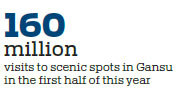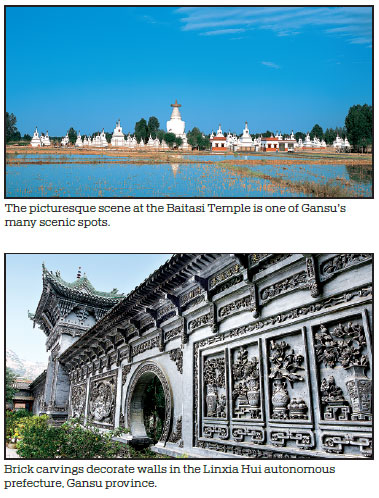Region transformed by tourism, preservation efforts
Northwest China's Gansu province saw robust growth and development in its tourism industry in the first half of 2019, according to local officials.
During that period, Gansu received 160 million visits and generated 113.43 billion yuan ($16 billion) in tourism revenue. It represents a year-on-year increase of 25.6 percent and 31 percent, respectively.
It joined with some areas from the Tibet autonomous region, provinces of Qinghai, Sichuan, Yunnan and the Xinjiang Uygur autonomous region to host promotions of tourism products and traveling routes.
Rural tourism has been a major focus in the province. Small villages have transformed their economies to provide better tourism facilities, such as hotels and homestays, as well as shopping and activities.
The Gansu government invited colleges, media organizations and enterprises to send a team to evaluate the performance of 104 rural tourism demonstration villages, which are piloting the new economic model.
The team will evaluate and provide consultation services to a further 100 villages wishing to become demonstration villages this year.

In the first six months, the provincial government earmarked 71.06 million yuan for impoverished regions to develop their tourism industries. The government invited a design team headed by Mi Qiu, a noted architect and artist, to Bulenggou village in the Linxia Hui autonomous prefecture to assist with planning and design.
Gansu also explored cooperation with eastern regions on developing tourism and signed a partnership agreement with the Tianjin culture and tourism bureau earlier this year.
Together they will promote cultural tourism projects and train related professionals. Additionally, Gansu increased investment efficiency and promoted major cultural tourism projects during the six-month period.
Local authorities earmarked 5 million yuan to support an overall plan for the greater Dunhuang cultural tourism economic circle. It centers on Dunhuang, known for its Mogao Grottoes, a UNESCO World Heritage site.
The government has supported Dunhuang Academy in speeding up the construction of the Mogao Grottoes' tourist service center.
A more versatile connection among scenic areas along the Yellow River has been urged, with night tours and live performances taking place on the river.
Financial support is a major factor behind the sustainable growth of local tourism.
The authorities cooperated with the Bank of China and China Development Bank, and encouraged financial institutions to support cultural tourism.
Thanks to the cooperation, the Guanegou scenic area in Longnan city secured a loan of 225 million yuan from the Gansu branch of the China Development Bank.
Out of that, 150 million yuan has been given to the tourism development company. The authorities have also called on local businesses to increase collaboration with other regions in China. Five cultural tourism companies from Gansu attended a Gansu-Hong Kong entrepreneurs' matchmaking event held in Shenzhen, Guangdong province, in June. There they sought cooperation opportunities for investment and projects.
Local officials said that they paid attention to projects that big conglomerates, such as Wanda, intend to invest in. The Silk Road (Dunhuang) International Cultural Expo and the Dunhuang Tour Silk Road International Tourism Festival, which ended on Aug 31, saw the signing of 50 Silk Road cultural tourism projects.
Gansu has been able to capitalize on opportunities brought by the Belt and Road Initiative. This allowed it to be prepared for the expo and the festival. Foreign guests, international tourism industry insiders and media representatives joined the events.
The province is also celebrating the artistry and creativity of its residents by holding many cultural activities from opera to art exhibitions.
The Gansu government organized for two large opera houses to perform in impoverished regions to inspire preservation of local culture, creativity and heritage.
Additionally, more stringent regulations have been introduced with regard to Gansu's sections of the Great Wall, as well as a policy on strengthening reform on the protection and use of cultural relics.
The government has launched projects to better protect statues and murals at Mogao Grottoes and the ruins of Yumen Pass, a strategic point on the ancient Silk Road.

(China Daily 09/05/2019 page12)














